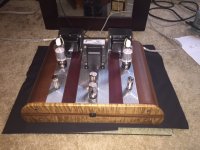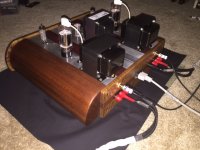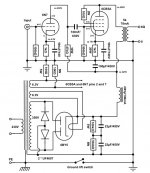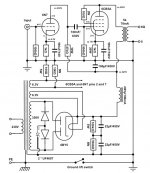I built this amp over the weekend using mostly Vinyl Savor's schematic. I swapped the rectifiers out for 6C33s and switched the driver to 6CG7s.
I ended up with 420V B+ on the 6CB5A tube plates. Is the additional 20V of any major consequence?
I ended up with 180V on the plates of the 6CG7s and 5V on the cathodes leaving the 1K cathode resistor and 47K plate load resistor.
I'm mostly concerned with whether or not I need to add another stage to drop a few volts to my PS.
Thanks!
I ended up with 420V B+ on the 6CB5A tube plates. Is the additional 20V of any major consequence?
I ended up with 180V on the plates of the 6CG7s and 5V on the cathodes leaving the 1K cathode resistor and 47K plate load resistor.
I'm mostly concerned with whether or not I need to add another stage to drop a few volts to my PS.
Thanks!
Attachments
Hi!
Nice build!
How much current do you have through the 6CB5A? You get that by checking the voltage on the cathode resistor. As long as plate dissipation does not get too high you should be fine.
Make sure the plate does not show any red spots. If plate dissipation gets too high you get some dull red glow on the plates. In that case dial the voltage back or increase the cathode resistor. In my experience the 6CB5A is quite tough.
The input sensitivity will be lower with the 6CG7. If your preamp provides enough voltage to drive it to full power it should be fine. I selected the 6N7 to get a decent input sensitivity.
For the 6CG7 I would use a different plate resistor, something like 27k. Did you wire both halves in parallel?
Thomas
Nice build!
How much current do you have through the 6CB5A? You get that by checking the voltage on the cathode resistor. As long as plate dissipation does not get too high you should be fine.
Make sure the plate does not show any red spots. If plate dissipation gets too high you get some dull red glow on the plates. In that case dial the voltage back or increase the cathode resistor. In my experience the 6CB5A is quite tough.
The input sensitivity will be lower with the 6CG7. If your preamp provides enough voltage to drive it to full power it should be fine. I selected the 6N7 to get a decent input sensitivity.
For the 6CG7 I would use a different plate resistor, something like 27k. Did you wire both halves in parallel?
Thomas
Last edited:
Hi Thomas!
Thanks for the note about the build! I have 420VDC on the plates, and ~73V on the cathodes. The plates have no glow after two hours of playing.
It definitely needs a little more push to get it up to volume, and I may end up swapping out the driver tube to something with a little more gain. Maybe a 12AT7 unless someone has another 9 pin suggestion that would be better.
If I swap out the plate resistor to 22K, does it need to be 10W like the 47K? That's the biggest driver tube plate load resistor I have ever seen. I usually use 1-2W. I only used 1/2 the 6CG7.
Thanks!
Thanks for the note about the build! I have 420VDC on the plates, and ~73V on the cathodes. The plates have no glow after two hours of playing.
It definitely needs a little more push to get it up to volume, and I may end up swapping out the driver tube to something with a little more gain. Maybe a 12AT7 unless someone has another 9 pin suggestion that would be better.
If I swap out the plate resistor to 22K, does it need to be 10W like the 47K? That's the biggest driver tube plate load resistor I have ever seen. I usually use 1-2W. I only used 1/2 the 6CG7.
Thanks!
Last edited:
Hi!
You should be fine then!
A 5W resistor would do as well. I like to derate resistors significantly
I wouldn't use the 12AT7. It is quite non-linear and that won't work well in such a NFB design.
With the 6N7 about 2V RMS is needed at the input to drive the amp to full power, With the 6CG7 you will need more than 3V.
Thomas
You should be fine then!
A 5W resistor would do as well. I like to derate resistors significantly
I wouldn't use the 12AT7. It is quite non-linear and that won't work well in such a NFB design.
With the 6N7 about 2V RMS is needed at the input to drive the amp to full power, With the 6CG7 you will need more than 3V.
Thomas
Hi!
I would recommend to change the plate resistor if you keep using the 6CG7. You wrote that you currently have 5V on it's cathode. Since you need 3V RMS, which is almost 5V peak, you have no headroom. As such the driver probably dominates the sound of the amp. It is good to have 6dB headroom. So I would reduce the plate resistor and maybe parallel the 6CG7 halves. Then play a bit with the cathode resistor.
Thomas
I would recommend to change the plate resistor if you keep using the 6CG7. You wrote that you currently have 5V on it's cathode. Since you need 3V RMS, which is almost 5V peak, you have no headroom. As such the driver probably dominates the sound of the amp. It is good to have 6dB headroom. So I would reduce the plate resistor and maybe parallel the 6CG7 halves. Then play a bit with the cathode resistor.
Thomas
Hi Thomas,
I have several sets of 6CB5 tubes. The set that was in when I typed all of this was fine. I have a set of black plate 6CB5s that do not have the rectangle cooling cutouts on the plates that slightly red plates when installed. I was getting upward of 435V on the plates with my supply, which has a 10H choke vs. your 20H, so I added a filter stage with a 150ohm resistor to get B+ down to around 410V. That helped the redplate, but it is not gone. Would adding some resistance in series with my choke be OK to drop an additional 10V? I have a ton of current still available, so I am not worried about taxing the transformer. Just concerned about choking out sonics.
Thanks!
I have several sets of 6CB5 tubes. The set that was in when I typed all of this was fine. I have a set of black plate 6CB5s that do not have the rectangle cooling cutouts on the plates that slightly red plates when installed. I was getting upward of 435V on the plates with my supply, which has a 10H choke vs. your 20H, so I added a filter stage with a 150ohm resistor to get B+ down to around 410V. That helped the redplate, but it is not gone. Would adding some resistance in series with my choke be OK to drop an additional 10V? I have a ton of current still available, so I am not worried about taxing the transformer. Just concerned about choking out sonics.
Thanks!
I still don't think that's the best way to do it.
When you increase the cathode resistor the voltage across it will increase and therefore make the grid more negative, when driven by large signals that tube will go into cutoff sooner. Basically you are shifting the operation point further away from class A.
I might be wrong but I still think lowering plate voltage is better.
When you increase the cathode resistor the voltage across it will increase and therefore make the grid more negative, when driven by large signals that tube will go into cutoff sooner. Basically you are shifting the operation point further away from class A.
I might be wrong but I still think lowering plate voltage is better.
I did add series resistance to drop B+ for experimental reasons. Oddly, even at 405V B+, all other 6CB5s start to get slight red plate in the corners of the plates.
I do, however have many Zeners like the one described. I've used this many times to accommodate for mains increases over the years in old amps.
I may try that as well.
The amp sounds beautiful!
I do, however have many Zeners like the one described. I've used this many times to accommodate for mains increases over the years in old amps.
I may try that as well.
The amp sounds beautiful!
Hi!
Another way would also be to reduce the first cap after the rectifier. I forgot that this version was with cap input filter.
And do add some resistance to the cathode R as well.
Some 6CB5As tend to show red plating earlier than others. But as mentioned they are tough and cheap to replace
Thomas
Another way would also be to reduce the first cap after the rectifier. I forgot that this version was with cap input filter.
And do add some resistance to the cathode R as well.
Some 6CB5As tend to show red plating earlier than others. But as mentioned they are tough and cheap to replace
Thomas
- Home
- Amplifiers
- Tubes / Valves
- Vinyl Savor 6CB5A SE Amps?




